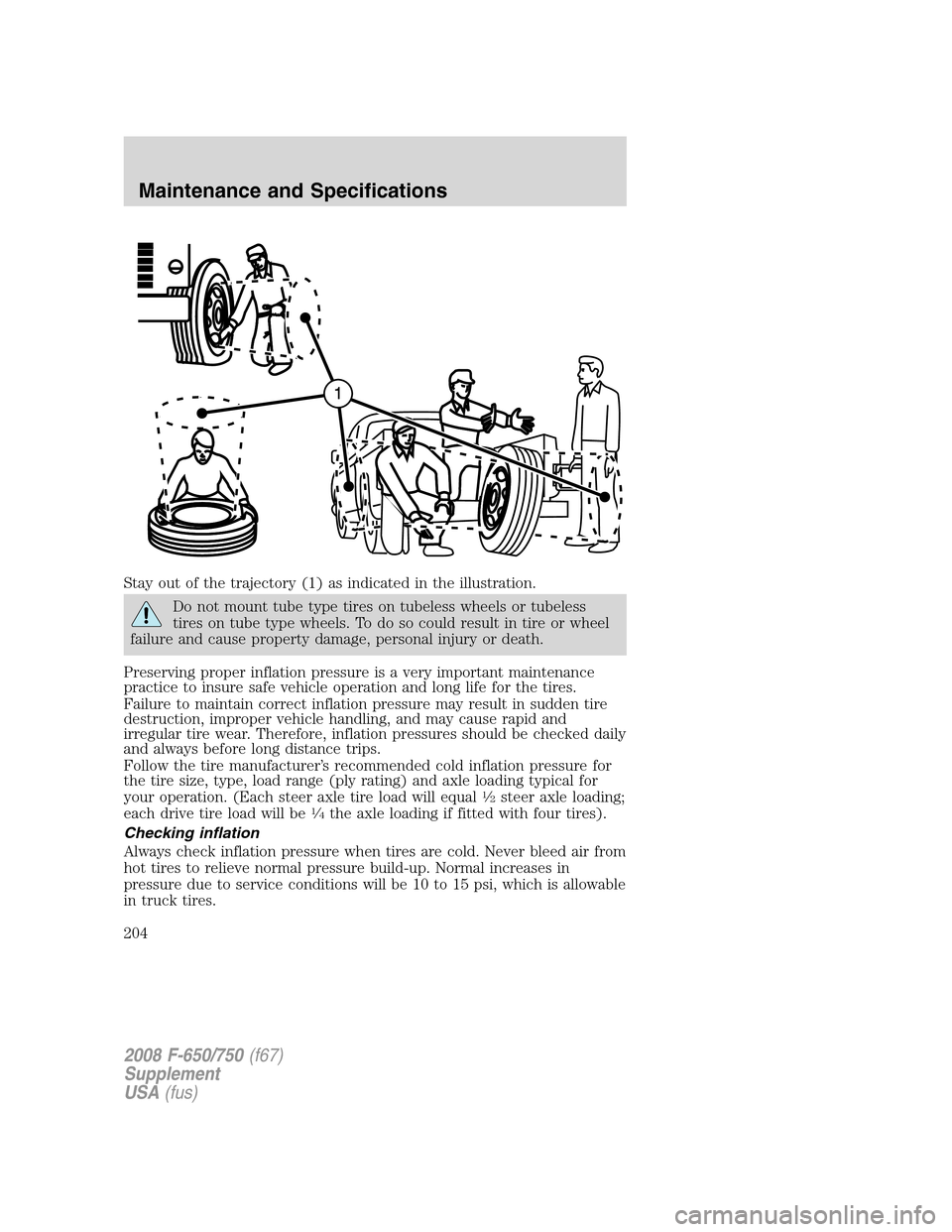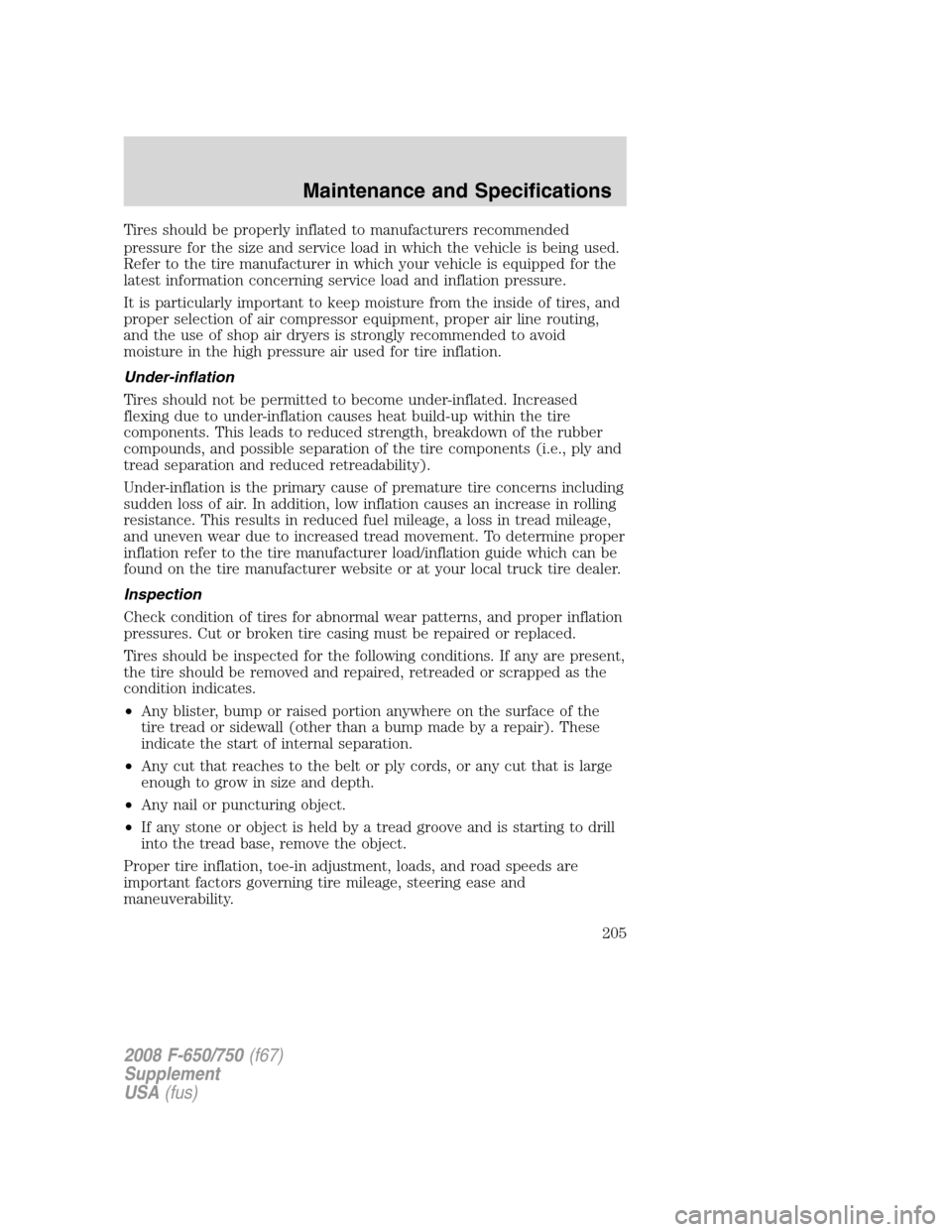2008 FORD F750 inflation pressure
[x] Cancel search: inflation pressurePage 163 of 273

Check to make sure that the axle mounting U-bolt nuts, attaching or
mounting bolts and nuts are securely tightened. Regularly check front
axle for damage, binding, worn parts and adequate lubrication.
At regular intervals, or during other scheduled maintenance, (tire
rotation/service, wheel bearing service, alignment, etc.) the kingpins
should be checked for excessive wear. Refer to the service manual for
proper procedures.
Toe-in setting - general inspection
Inspecting steer axle tires in the first 3,000–10,000 service miles
(4,800–16,000 service km) will generally show if tires are wearing
normally.
Rapid outside shoulder wear on both tires indicates too much toe-in.
Rapid inside shoulder wear on both tires indicates too much toe-out. In
P&D-type service, left-to-right steer tire tread life differentials up to 40%
can be observed depending on routes and other variables.
Follow the tire manufacturer’s recommended cold inflation pressure for
the tire size, load range (ply rating) and steer axle loading typical for
their operation (each steer axle tire will equal
1�2steer axle loading).
Special applications may warrant a setting based on past experience with
the type of tire operating loads and conditions. Radial tires are more
sensitive to toe-in setting than bias ply tires. While not insensitive to
vehicle alignment, fine tuning school bus alignment to line-haul truck
standards will not drastically improve tire tread life.
It is essential that correct toe-in and tire pressure be maintained for
optimum tire wear.
Rear axle - general inspection
Check to make sure that the axle mounting U-bolts, attaching or
mounting bolts and nuts are securely tightened. Refer toU-bolt nut
torquein this chapter. Regularly check the rear axle for damaged,
binding or worn parts.
NoSpin Detroit Locker positive locking differential
Vehicles equipped with this type differential have the operator’s manual
supplied with the vehicle. Refer to this manual for maintenance checks.
Brake system - general inspection
Your vehicle is equipped with non-asbestos brake linings. However,
exposure to excessive amounts of brake material (whether asbestos or
2008 F-650/750(f67)
Supplement
USA(fus)
Maintenance and Specifications
162
Page 202 of 273

Use only the same type and style wheels and mounting hardware
to replace original parts. Failure to do so may result in an
assembly that looks fine, but does not fit together properly. This could
possibly cause wheel or fastener failures which could result in property
damage, personal injury or death.
Note:Do not attempt to mix stud-piloted wheels or fasteners with
hub-piloted wheels or fasteners.
Note:Do not change from aluminum wheels to steel wheels or
vice-versa without changing the mounting hardware required or, with
flange-nut mounting systems, changing the hub and stud assembly.
WHEEL NUT TORQUE
Size Nut mountingTorque
Ft. lb. N•m
22 mm Flange 450–500 610–678
Note:Do not use lubrication on dry threads. Where excessive corrosion
exists, a light coat of lubricant on the first three threads of the stud bolt
is permitted. Keep lubricant away from:
•Hex nut and rim clamp contact surfaces.
•Cap nut ball face and ball seat on the disc wheel.
•Flange nut washer surface and flat on the disc wheel.
TIRE INFORMATION
Inflation
Always maintain your tires in good condition. Frequently check
and maintain correct inflation pressures as specified by tire
manufacturers. Inspect periodically for abnormal wear patterns and
repair/replace cut or broken tire casing. Always use experienced,
trained personnel with proper equipment and correct procedures to
mount or remove tires and wheels. Failure to adhere to these warnings
could result in wheel or tire malfunction, damage to your vehicle,
personal injury, or death.
2008 F-650/750(f67)
Supplement
USA(fus)
Maintenance and Specifications
201
Page 204 of 273

All tires with Steel Carcass Plies (if equipped):
This type of tire utilizes steel cords in the sidewalls. As such, they
cannot be treated like normal light truck tires. Tire service, including
adjusting the air pressure, must be performed by personnel trained,
supervised and equipped according to Federal Occupational Safety and
Health Administration (OSHA) regulations. For example, during any
procedure involving tire inflation, the technician or individual must
utilize a remote inflation device, and ensure that all persons are clear of
the trajectory area.
WARNING An inflated tire and rim can be very dangerous if
improperly used, serviced or maintained. To avoid serious injury,
never attempt to re-inflate a tire which has been run flat or seriously
under-inflated without first removing the tire from the wheel assembly
for inspection. Do not attempt to add air to tires or replace tires or
wheels without first taking precautions to protect persons and
property.
2008 F-650/750(f67)
Supplement
USA(fus)
Maintenance and Specifications
203
Page 205 of 273

Stay out of the trajectory (1) as indicated in the illustration.
Do not mount tube type tires on tubeless wheels or tubeless
tires on tube type wheels. To do so could result in tire or wheel
failure and cause property damage, personal injury or death.
Preserving proper inflation pressure is a very important maintenance
practice to insure safe vehicle operation and long life for the tires.
Failure to maintain correct inflation pressure may result in sudden tire
destruction, improper vehicle handling, and may cause rapid and
irregular tire wear. Therefore, inflation pressures should be checked daily
and always before long distance trips.
Follow the tire manufacturer’s recommended cold inflation pressure for
the tire size, type, load range (ply rating) and axle loading typical for
your operation. (Each steer axle tire load will equal
1�2steer axle loading;
each drive tire load will be1�4the axle loading if fitted with four tires).
Checking inflation
Always check inflation pressure when tires are cold. Never bleed air from
hot tires to relieve normal pressure build-up. Normal increases in
pressure due to service conditions will be 10 to 15 psi, which is allowable
in truck tires.
2008 F-650/750(f67)
Supplement
USA(fus)
Maintenance and Specifications
204
Page 206 of 273

Tires should be properly inflated to manufacturers recommended
pressure for the size and service load in which the vehicle is being used.
Refer to the tire manufacturer in which your vehicle is equipped for the
latest information concerning service load and inflation pressure.
It is particularly important to keep moisture from the inside of tires, and
proper selection of air compressor equipment, proper air line routing,
and the use of shop air dryers is strongly recommended to avoid
moisture in the high pressure air used for tire inflation.
Under-inflation
Tires should not be permitted to become under-inflated. Increased
flexing due to under-inflation causes heat build-up within the tire
components. This leads to reduced strength, breakdown of the rubber
compounds, and possible separation of the tire components (i.e., ply and
tread separation and reduced retreadability).
Under-inflation is the primary cause of premature tire concerns including
sudden loss of air. In addition, low inflation causes an increase in rolling
resistance. This results in reduced fuel mileage, a loss in tread mileage,
and uneven wear due to increased tread movement. To determine proper
inflation refer to the tire manufacturer load/inflation guide which can be
found on the tire manufacturer website or at your local truck tire dealer.
Inspection
Check condition of tires for abnormal wear patterns, and proper inflation
pressures. Cut or broken tire casing must be repaired or replaced.
Tires should be inspected for the following conditions. If any are present,
the tire should be removed and repaired, retreaded or scrapped as the
condition indicates.
•Any blister, bump or raised portion anywhere on the surface of the
tire tread or sidewall (other than a bump made by a repair). These
indicate the start of internal separation.
•Any cut that reaches to the belt or ply cords, or any cut that is large
enough to grow in size and depth.
•Any nail or puncturing object.
•If any stone or object is held by a tread groove and is starting to drill
into the tread base, remove the object.
Proper tire inflation, toe-in adjustment, loads, and road speeds are
important factors governing tire mileage, steering ease and
maneuverability.
2008 F-650/750(f67)
Supplement
USA(fus)
Maintenance and Specifications
205
Page 208 of 273

If rib tire is used on front axle and lug or off-road type on rear axle
positions:
1.Front (Steering) Axle:Replace tires at front wheels when tread is
worn to 4/32 inch (3 mm) or less.
2.Rear Axles:Tires must be removed when the tread is worn to
2/32 inch (2 mm) or less. Tires identified with the word “re-groovable”
molded on the sidewall can be re-grooved. A minimum of 3/32 inch
(2.5 mm) of under-tread must be left at the bottom of the grooves.
Wheel and tire balancing
Out-of-round or out-of-balance wheels or tires can cause vehicle
vibration, bounce and shimmy. Replace damaged or out-of-round wheels.
Out-of-round tires and wheel assemblies can be corrected by re-clocking
the tire relative to the wheel.
The tire and wheel assembly should then be dynamically balanced.
Wear
Radial tires can exhibit three types of normal wear patterns: 1) Even,
2) Erosion, 3) Chamfer.
Even wearis a sign that the tire is being properly used and maintained.
Erosion wearhas also been called rolling wear, channel or river wear.
Erosion wear is found more often at free rolling tires. This is an
indication that the tire is being used in a slow wearing operation. What
happens is that the belt plies are held very rigid and the tread is not
allowed to distort as it passes through the contact area. Wear will only
occur at the edge of the tread. No corrective action required. If erosion
gets to be 1/16 inch (2 mm) or more, the tire may be rotated to a drive
axle.
Chamfer or shoulder wear,with tires inflated properly, is a normal
tendency of most radial tire designs. If both inside and outside shoulders
are wearing evenly around the tire, no further action is required.
Over-inflation is not effective in correcting this effect.
Tires: Irregular Wear
If irregular wear is present, check the axle alignment, tire pressure,
wheel balancing, shock and suspension component condition, and wheel
bearing end play.
This condition not only shortens tire life, but will adversely affect the
handling of your vehicle, which is dangerous.
2008 F-650/750(f67)
Supplement
USA(fus)
Maintenance and Specifications
207
Page 209 of 273

Rotating tires from one wheel position to another is a way often used to
even out many types of irregular wear or to avoid it altogether. Some of
the more effective tire rotation programs are:
•Steer tires that have developed some type of irregular wear pattern
can be rotated to drive axles if rib tires are being used on all wheel
positions. Applying steer tires to a drive position will often clean them
and they can be moved back to the steer axles or run out to re-tread
stage on the rear axle.
•Another rotation possibility for fleets with rib tires in all wheel
positions is to break in the new steer tires in the drive axle positions,
then move them to steer axles. This will wear away tread rubber
relatively quickly in the early life of a tire when it is most likely to
develop an unusual wear pattern.
•Drive axle tires may be placed on the other end of the same axle so
that direction of rotation is reversed. This is often helpful if a heel and
toe or alternate lug wear pattern has developed.
Irregular wear can be minimized by:
•Using the right inflation pressure for the load being carried.
•Maintaining proper front wheel alignment -especially toe-in-to
specifications.
•Maintaining proper tire and wheel balance.
•Maintaining shock absorbers and suspension components.
Use of tire chains
Refer to chain manufacturer’s recommendation for correct tire chain
usage, installation and removal.
2008 F-650/750(f67)
Supplement
USA(fus)
Maintenance and Specifications
208